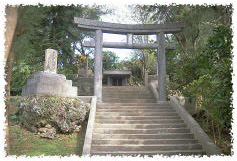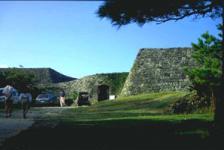Brief History of Yomitan Village
1. "Yontanja" described in the old record of "Omorososhi"
Yomitan Village was located in the north end of Chuzan Kingdom in the olden times and it was called "Ufunishi (Great North)" in those days. A collection of old Ryukyu poems, "Omorososhi" describes Yomitan Village as "Yontamoza" and "Yontamuza." Due to its geographic feature of having a cape that project into the sea, it was also called "Sakiyota (cape branch). Yontamoza or Yontamuza was later changed to "Yuntanja" which was used for a certain period to indicate a large area of the northern Chuzan Kingdom and it included the southern half of present Onna Village.
2. Taiki from Uza District of Yomitan Village, A Man Sent to China
In 1372, King Satto sent Taiki to China (Min Dynasty) and allowed him to call himself a brother of the King. This was the first man from Okinawa who was sent to China by the King of the Ryukyu Kingdom, which opened the way to a successful tribute trade with China.
The poems in Omorososhi praise the first tribute trade ship (the blessing song of Furugen Noro) and Taiki (the welcome song for the returned trade ship) whose courageous behavior made him the kingdom's hero. Taiki returned to China several times for trade with China (Min Dynasty) and brought back many things including books and document. Taiki made a significant impact on the future glory of the Kingdom which resulted from the tribute trade with China.
3. Akainko, A Man of Songs and Sanshin
 Akainko was a man who lived during the rule of King Shoshin, who was a member of the Second Sho-shi royal family of the Ryukyu Kingdom, and he was an excellent singer of Omoro songs.
Akainko was a man who lived during the rule of King Shoshin, who was a member of the Second Sho-shi royal family of the Ryukyu Kingdom, and he was an excellent singer of Omoro songs.
Omorososhi contains approximately 40 Akainko related poems which are written following "Omoro haneagari, Akainko ga Omorososhi" (volume 8 of Omorososhi). Akainko was born in Sobe, Yomitan Village and visited many villages in the central and southern districts of Okinawa Island. His beautiful singing voice and Sanshin, a three-string musical instrument moved the people who listened to him.
(Photo: Shrine of Akainko which was erected at the place of Akainko's death)
4. Zakimi Castle Construction
 In or around 1422, Gosamaru, the Aji (the regional lord) of the region, constructed Zakimi Castle according to the order of King Shohashi of the Ryukyu Kingdom. Gosamasu moved to the completed Zakimi Castle from Yamada Castle to rule Yuntanja region for 20 years looking down over Nagahama Port, a fine harbor, from the castle. In 1440, Gosamaru was ordered to move to Nakagusuku Castle by the King of Chuzan. In 1477, King Shoshin ascended to the throne and called all Ajis to Shuri, where the king's castle (Shuri Castle) was constructed to introduce the centralization of administrative power. The local administration was under "the Aji Okite (the rules of Aji)."
In or around 1422, Gosamaru, the Aji (the regional lord) of the region, constructed Zakimi Castle according to the order of King Shohashi of the Ryukyu Kingdom. Gosamasu moved to the completed Zakimi Castle from Yamada Castle to rule Yuntanja region for 20 years looking down over Nagahama Port, a fine harbor, from the castle. In 1440, Gosamaru was ordered to move to Nakagusuku Castle by the King of Chuzan. In 1477, King Shoshin ascended to the throne and called all Ajis to Shuri, where the king's castle (Shuri Castle) was constructed to introduce the centralization of administrative power. The local administration was under "the Aji Okite (the rules of Aji)."
(Photo: Zakimi Castle (constructed by Gosamaru in 1420 or a few years later)
5. Kina Bansho
Aji Okite (the rules of Aji, regional lord) was abolished in 1611, and "Jito-dai" (Head of a region, called Majiri) was introduced. In those days, there were 25 communities (called Mura) in Yuntanja Majiri (present Yomitan Village) which included Chatan and its southern areas. In 1673, however, 9 muras (villages) were severed from Yuntanja and annexed into Onna Majiri. In or around 1820, the administrative office was transferred from Zakimi bansho within Zakimi Castle to Kina (called Kina bansho) where a busy street connecting Shuri and Kunigami (northern areas) was constructed.
(Photo: Kina Bansho, Painting by Ryoshu Miyahira) (Photo: Present Kina Bansho)
6. Formation of Present Yomitan Village
In 1897, according to the provision of the Majiri Officers Rule, the head of Majiri in Okinawa was changed to Majiri-cho from Jito-dai, Bansho was changed to Majiri Yakuba, and new officers, such as the treasurer and secretary, were introduced. In 1899, the Okinawa Prefecture Land adjustment Law was implemented and readjustment of mura (village) communities was introduced. Nagata, Makihara and Oyashi mura became independent from Iramina, Owan and from Kina mura respectively; 16 muras (Kina, Zakimi, Iramina, Uechi, Namihira, Taskashiho, Tokeshi, Gima, Uza, Senaha, Nagahama, Sobe, Toguchi, Hija, Owan, and Furugen) became 19 muras. Hijabash (in 1914), Ogi (in 1935), and Toya (in 1946) became independent Azas from Owan, Sobe/Owan, and Zakimi respectively. Yomitan Village has 22 Azas at present.
7. Post-War Period: "The Village of a United States Military Base"
The United States Armed Forces landed on the coast of Yomitan Village on the onset of the Battle of Okinawa during the Second World War. The village was bombarded fiercely and the green land was burnt to the ground. In August of 1946, some of the villagers were permitted to return to their land in Namihira and Takashiho. More than 600 villagers joined to form the Yuntanja Reconstruction Group and started the reconstruction of the village. By November 1946, the first group of villagers under the reconstruction project were able to settle in the village, which was followed by more returning villagers. On December 16, 1946, the village name was changed from Yuntanja to Yomitan Village. The villagers welcomed the name change since it symbolizes the hope for the future and the beginning of a new era. However, a large portion of the land in Yomitan is still used as a U.S. military base. With the implementation of the peace treaty with Japan on April 28, 1952, Okinawa was separated from the Japanese administration and put under United States administration, which made Yomitan Village "the village of a U.S. military base."
(Photo: A standard House Constructed by the Yomitan Reconstruction Group)
(Photo: Original Administrative Document Prepared at the Time of Reconstruction)
8. Post-Reversion "Creation of a Cultural Village"
The United States administration of Okinawa ended with Okinawa's reversion to Japan in 1972. However, the Okinawan people's earnest desire for the reversion to establish peaceful islands without any existence of "nuclear arms and U.S. military bases" did not come true. Although a portion of the military base land was returned, much of the land is still being used for military bases. Under the circumstances, the reconstruction of the village began. The village has put a lot of efforts into engaging in various work projects to establish an independent cultural village whose goals include: the creation of "a village with rich nature and cultural assets." The weaving of Yuntanja Hanaui (a unique, woven and colorful textile ) has been revitalized. Yachimun-no-sato was constructed to provide a kiln and places to make pottery. Yomitan Festival has been held annually for young and old villagers to show their unique performing arts on stage. The population of the village has steadily grown. There are 22 Azas in the village Ozoe-aza was added in 1985. The village has also been promoting agricultural products such as Beni-imo (purple or pink sweet potatoes) and commercial flower raising. The social and economic development can be seen in the development of a golf course by the developer who is a native villager. Almost fifty years have passed after the end of World War II and twenty five years after the Okinawa's reversion to Japan. Today, Yomitan village is heading for the new era and the coming 21st century.
(Photo: An Aerial View of Yomitan village)
| 1372 | Taiki (a man from Uza, Yomitan Village) was sent on a tribute trade ship to China (Min Dynasty) by the King of the Ryukyus to represent Okinawa |
| 1442 | Zakimi Castle was constructed by Gosamaru, the lord of Yomitan area |
| 1897 | The system of "Majiri and Its Head" was introduced |
| 1899 | According to Okinawa Prefecture Land Adjustment Law, communities very similar to the present village have been established in Yomitan |
| 1908 | The village was named Yuntanja Village: a new municipal administration was established |
| 1943~1944 | The land of presently occupied by Yomitan Air Field was requisitioned by the Japanese Armed Forces |
| 1945 | U.S. Armed Forced landed and occupied the village of Yomitan |
| 1946 | Parts of Namihira and Takashiho in Yomitan Village were allowed to be used by the villagers for their housing in August. A group of villagers formed the "Yomitan Reconstruction Group" and began reconstruction. In December, the village's name was changed to "Yomitan Village." The office was transferred to Namihira from Kina (former Kina Majiri Bansho) |
| 1972 | Okinawa was returned to Japanese administration |
| 1973 | The reconstruction of Zakimi Castle began |
| 1975 | Yomitan Village History & Folklore Museum was opened. |
| 1976 | Yomitan Kyugo Institution was opened; Land survey at Bollo Point was Conducted; Land Improvement Project began. |
| 1977 | Yomitan Village Clinic was opened; Toya-no-sato was opened. |
| 1978 | Sports Ground was opened; Nobori-gama (a long pottery kiln) for joint use was constructed at Yachimun-no-sato (a place of pottery); A public facility improvement project at the released land of Toguchi began; Nagahama Dam project was requested. |
| 1979 | Integrated Welfare Center was opened |
| 1980~1981 | Furugen Land Readjustment Project began; Workers Gym was opened; Zanpa Point Park Improvement Project began; Traditional Crafts Center was opened; Improvement work on the released land of Uza began. |
| 1983~1984 | Improvement work of the released land of Gima began; The improvement works of Yomitan Village Heiwa-no-mori Stadium began. |
| 1985~1986 | The construction of the Village Women's House and improvement work on a ~1986 public institution on the released land of Kina began; Yomitan Village multiple purpose square was opened. |
| 1990~1997 | An Art Museum was opened; Pottery Training Center was opened; Local public Sewer system in Sobe area began its service. A new village office building was constructed within the compound of Yomitan Airfield. |
List of Prizes Awarded to Yomitan Village
| 1974 | "Municipal Government Prize" was awarded by Okinawa Times |
| 1984 | "Best Town Prize" by the Minister of Home Affairs (GOJ) |
| 1987 | "Village Amenity Prize" for Zakimi District by the Director-General of National Land Agency (GOJ) |
| 1989 | "Miyazaki Prize" by Kobe Urban Issue Research Institute (Foundation) |
| 1995 | "Rich Village Prize" for Toguchi by the Minister of Agriculture, Forestry and Fisheries (GOJ: Government of Japan) |
| 1997 | "National Green Protection Meritorious Service" for Zakimi District by the Minister of Construction (GOJ) |
| 1998 | "National Green Protection Meritorious Service" for Ogi District by the Minister of Construction (GOJ) |
